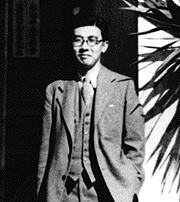Sony Corporation is the electronics business unit and the parent company of the Sony Group, which is engaged in business through its five operating segments — electronics, games, entertainment (motion pictures and music), financial services and other. These make Sony one of the most comprehensive entertainment companies in the world. Sony's principal business operations include Sony Corporation (Sony Electronics in the U.S.), Sony Pictures Entertainment, Sony Computer Entertainment, Sony BMG Music Entertainment, Sony Ericsson and Sony Financial Holdings. As a semiconductor maker, Sony is among the Worldwide Top 20 Semiconductor Sales Leaders. The company's slogan is Sony. Like no other.[3]
History

In 1945, after World War II, Masaru Ibuka started a radio repair shop in a bombed-out building in Tokyo.[4] The next year, he was joined by his colleague Akio Morita and they founded a company called Tokyo Tsushin Kogyo K.K.[5], which translates in English to Tokyo Telecommunications Engineering Corporation. The company built Japan's first tape recorder called the Type-G.[6]
In the early 1950s, Ibuka traveled in the United States and heard about Bell Labs' invention of the transistor.[7] He convinced Bell to license the transistor technology to his Japanese company. While most American companies were researching the transistor for its military applications, Ibuka looked to apply it to communications. Although the American companies Regency and Texas Instruments built the first transistor radios, it was Ibuka's company that made them commercially successful for the first time.
In August 1955, Tokyo Telecommunications Engineering released the Sony TR-55, Japan's first commercially produced transistor radio.[8] They followed up in December of the same year by releasing the Sony TR-72, a product that won favor both within Japan and in export markets, including Canada, Australia, the Netherlands and Germany. Featuring six transistors, push-pull output and greatly improved sound quality, the TR-72 continued to be a popular seller into the early sixties.
In May 1956, the company released the TR-6, which featured an innovative slim design and sound quality capable of rivaling portable tube radios. It was for the TR-6 that Sony first contracted "Atchan", a cartoon character created by Fuyuhiko Okabe, to become its advertising character. Now known as "Sony Boy", the character first appeared in a cartoon ad holding a TR-6 to his ear, but went on to represent the company in ads for a variety of products well into the mid-sixties.[9] The following year, 1957, Tokyo Telecommunications Engineering came out with the TR-63 model, then the smallest (112 × 71 × 32 mm) transistor radio in commercial production. It was a worldwide commercial success.[10]
University of Arizona professor Michael Brian Schiffer, Ph.D., says, "Sony was not first, but its transistor radio was the most successful. The TR-63 of 1957 cracked open the U.S. market and launched the new industry of consumer microelectronics." By the mid 1950s, American teens had begun buying portable transistor radios in huge numbers, helping to propel the fledgling industry from an estimated 100,000 units in 1955 to 5,000,000 units by the end of 1968. However, this huge growth in portable transistor radio sales that saw Sony rise to be the dominant player in the consumer electronics field[11] was not because of the consumers who had bought the earlier generation of tube radio consoles, but was driven by a distinctly new American phenomenon at the time called rock and roll.
Origin of name

When Kogyo was looking for a romanized name to use to market themselves, they strongly considered using their initials, TTK. The primary reason they did not is that the railway company Tokyo Kyuko was known as TKK.[12]. The company occasionally used the acronym "Totsuko" in Japan, but during his visit to the United States, Morita discovered that Americans had trouble pronouncing that name. Another early name that was tried out for a while was "Tokyo Teletech" until Morita discovered that there was an American company already using Teletech as a brand name.[13]
The name "Sony" was chosen for the brand as a mix of the Latin word Sony or son(us) and also a little boy sonny, which is the root of sonic and sound as well as familiar word of everybody called a boy in February 1955, and company name changed to Sony in January 1958. Morita pushed for a word that does not exist in any language so that they could claim the word "Sony" as their own (which paid off when they successfully sued a candy producer using the name, who claimed that "Sony" was an existing word in some language).[12]
At the time of the change, it was extremely unusual for a Japanese company to use Roman letters instead of kanji to spell its name. The move was not without opposition: TTK's principal bank at the time, Mitsui, had strong feelings about the name. They pushed for a name such as Sony Electronic Industries, or Sony Teletech. Akio Morita was firm, however, as he did not want the company name tied to any particular industry. Eventually, both Ibuka and Mitsui Bank's chairman gave their approval.[14]

No comments:
Post a Comment